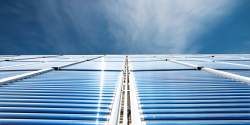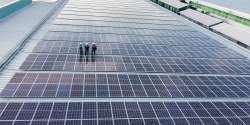Read Time : 3 Minutes
What are Organic Solar Cells
They are the third generation of solar cell technology, and also known as organic photovoltaic cells (OPV). These organic cells are incredibly powerful when it comes to absorbing the light from the sun. They are able to gather a larger amount of sunlight than any other solar cells. It has been noted that the future of solar technology lies in organic power. Even when regular solar technologies are able to catch up and match the organic power, it still won’t be able to overtake.
Organic power has almost limitless possibilities thanks to the exceptional properties it possesses. OPV is a solar cell technology that is rapidly increasing in terms of technological advancements and popularity. It has several advantages, including the fact that it is incredibly lightweight, can cover a much larger area, and also has low manufacturing costs. OPV are thinly filmed solar cells that have the potential to store much larger amounts of solar energies than other solar technologies.
This form of solar power will drive the industry forward at rapid speeds, especially with new research and development making it possible for them to have increased sustainability. An organic cell, also known as a plastic solar cell, is a type of polymer solar cell that utilises organic electrons. These are a branch of electronics that deal with conductive organic polymers, or small organic modules, in order for light absorption to take place as well as charge transport. This is so that electricity can be produced from sunlight via the photovoltaic effect.
The OPV convert solar energy into electrical energy at rates that are far more efficient than any other form of solar cell technology, even the silicon cells that are found in the majority of solar panels. If you find yourself interested in this form of solar technology and would like some information on pricing and installation, we are here to help you out. Simply fill in the no-obligation form on this page, and one of our professional installers will get back to you with offers and quotes. It’s free and only takes a minute to complete.
COMPARE PRICES FROM LOCAL INSTALLERS
Compare prices from local companies fast & free
Enter your postcode to compare quotes from leading professionals. We promise to keep your information Safe & Secure. Privacy Policy
The Advantages of Organic Solar Cell
As we’ve previously mentioned, organic solar cells have the ability to utilise much larger areas than the other forms of solar technology. They contain flexible solar modules, allowing the organic cells to be fabricated using a roll-to-toll system. This process is less expensive than the traditional methods of manufacture. The flexibility of the module also means that it is far more durable than its predecessors, so it ends up lasting longer and withstanding more.
This new and exciting development in solar technology means that portable electric devices (such as phones, tablets, and music players), could end up being charged while you are on the move, even in areas of low light and shading. This could be achieved through an organic solar cell that generates a voltage high enough to directly recharge a lithium-ion battery without needing to connect multiple individual cells. There are elements of these high voltage cells that perform better in various lighting conditions, even those that are in low levels of sunlight. The latter of which is the ideal setting for general electronic devices.
At the moment, this technology is only in the testing phase, but the success rates have been high, and the process looks to be a very promising one. The next step is to make the technology available outside of the lab and have cheap OPV chargers available for commercial purchase. Here are some of the advantages:
- Lightweight and flexible
- Semi-transparent characteristics
- Easy to integrate with other products
- New marketing opportunities (design features such as flexibility, lightweight, etc.)
- Low manufacturing costs compared to current solar technology
- Which then leads to a lower purchase cost
- Can be produced continuously using printing tools, efficient production
- Low environmental impact when manufactured
- Short energy payback times
The Disadvantages of Organic Solar Cells
For the organic solar cells to match the performance of silicon solar cells, and even exceed it, the donor and acceptor materials that are used in an OPV must have excellent extinction coefficients (which refers to several differing measure of the absorption of light in a medium), high stability, and a sturdy film structure. Organic solar cells undoubtedly have a higher level of efficiency than their silicon-based counterparts.
However, their operational lifetime is not as long. While this is their current limitation, the technology is still in the development phase. Various new materials, construction models and technological tweaks are currently being performed in order to try and rectify this disadvantage.
Cost of Organic Solar Cells
Today, only a small amount of power is generated by solar cells across the globe. The conversion of energy from the sun into electricity and heating for our homes and businesses has still not reached as many homes as we would like. A lot of the reason for this is that solar powered technology is still too expensive for everyone to benefit from it. Crystalline silicon is the primary material used in solar cells, and this is an expensive material that doesn’t help the consumer price of panels. Plus, the efficiency level of this is only averaging around 10%.
When we take this into consideration, along with the cost of installation, panel support, wiring, and DC to AC converters, the price of solar cells really starts to rise. In addition to this, the lifespan of a solar panel is approximately 30 years, so a new one would have to be installed after this time. Organic solar cells really are the next step when it comes to the development of solar energy.
It is hoped they will make solar panels more widely affordable so that more homes can benefit from solar energy. This is due to the cost reduction of cell manufacture as they are cheaper than the silicone ones. Organic solar cell technology may be new, and going through a lot of further research and development, but the estimated cost of manufacture for purely organic cells should range between £30 and £90 per square metre. That’s already worlds cheaper.
Find a local installer
Welcome to the biggest directory of UK renewable energy companies





 How Much do Solar Panel Systems Cost in 2024?
How Much do Solar Panel Systems Cost in 2024?







